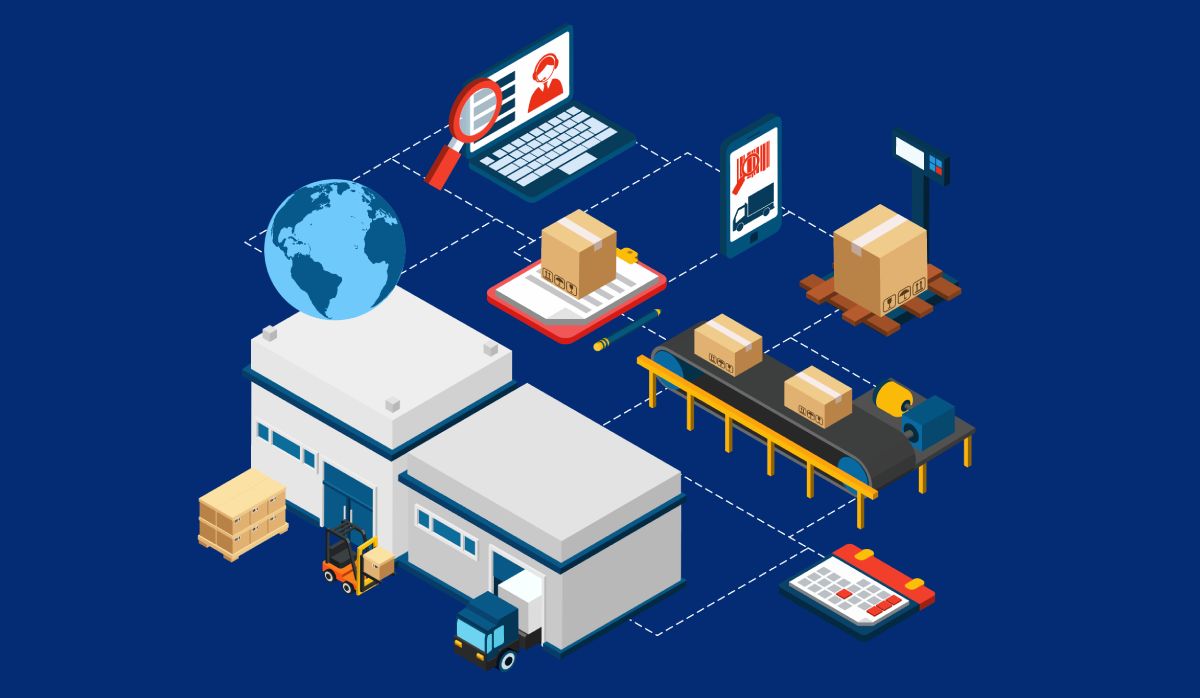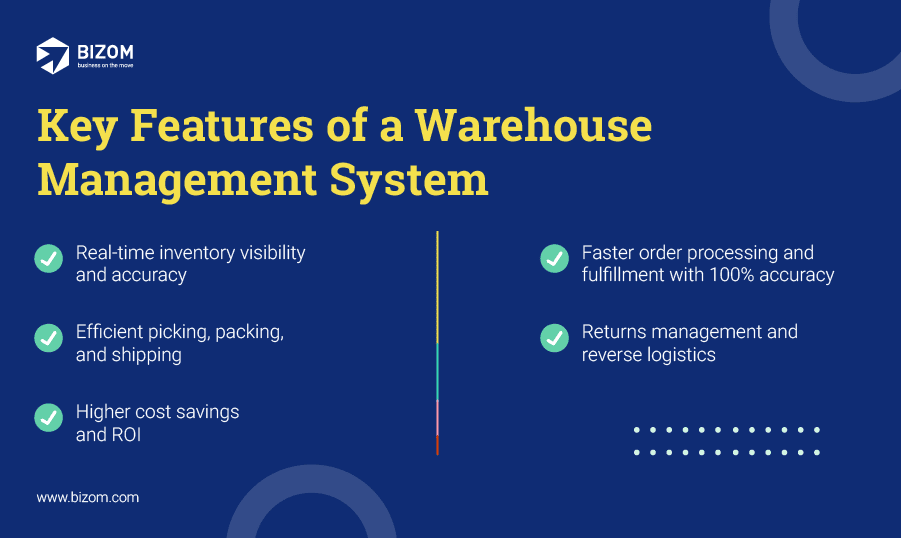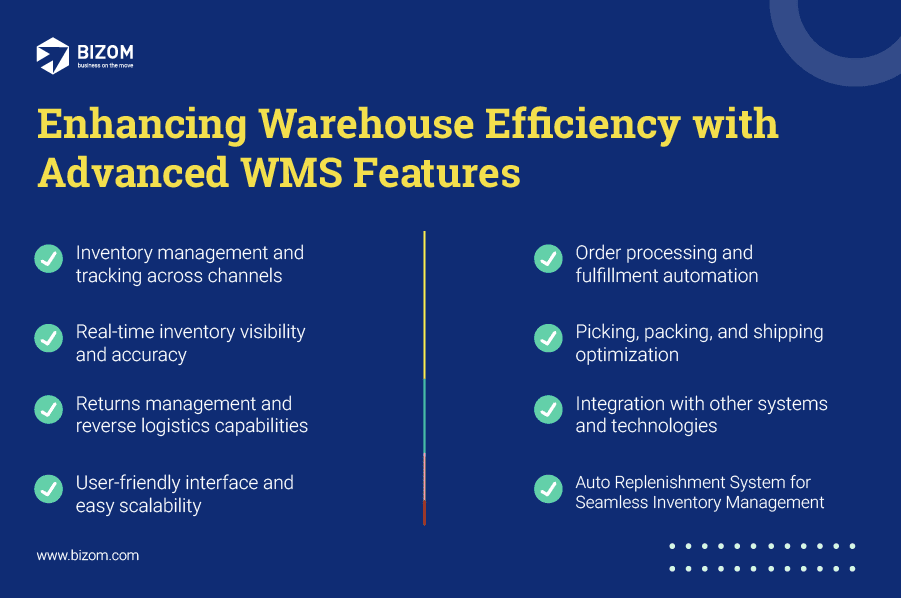Steps to build a competent Warehouse Management System
by Bizom
April 19 | 09 min read
Share:

In today’s world, where e-commerce is rapidly gaining popularity, efficient warehouse management has become crucial for businesses to stay competitive. A market research report by Markets and Markets forecasts that the global market for warehouse management systems is expected to witness significant growth from USD 2.8 billion in 2021 to USD 6.1 billion by 2026, with a compounded annual growth rate of 16.7% between 2021 and 2026. With such significant growth, businesses need to adopt the latest technologies to keep up with the competition. One such technology is the Warehouse Management System (WMS).
In this blog, we will discuss the steps to build a competent Warehouse Management System to ensure omnichannel fulfillment success. We will delve into the benefits of using a WMS, the challenges of omnichannel fulfillment, key features, best practices, and the role of a WMS in addressing these challenges.
Key Features of a Warehouse Management System

A robust Warehouse Management System can help businesses manage inventory across multiple channels by providing real-time inventory visibility and tracking. This ensures businesses can accurately manage inventory levels, avoiding stock outs and overstocking. With a WMS, businesses can also manage inventory in transit, ensuring that products are delivered to the correct channel at the right time. Let’s delve deeper into the importance of an optimized WMS for omnichannel fulfillment success.
Real-time inventory visibility and accuracy
Real-time inventory visibility and accuracy are critical for omnichannel fulfillment success. With an efficient Warehouse Management System, businesses can track inventory levels in real-time and ensure accurate inventory management. This enables businesses to quickly identify and resolve any inventory discrepancies, reducing the risk of stockouts or overstocking.
Faster order processing and fulfillment with 100% accuracy
A reliable WMS can help businesses process and fulfill orders quickly and accurately. With features such as automated order processing and picking optimization, businesses can fulfill orders faster and with fewer errors. This improves customer satisfaction and helps businesses compete in the market.
Efficient picking, packing, and shipping
Efficient picking, packing, and shipping are crucial for successful omnichannel fulfillment. With a robust WMS, businesses can optimize their picking and packing processes, reducing the time and effort required to fulfill orders. This ensures that orders are shipped quickly and accurately, improving customer satisfaction and reducing shipping costs.
Returns management and reverse logistics
With a high-performing WMS, businesses can manage returns efficiently, reducing the time and cost associated with the returns process. A WMS can also provide businesses with valuable insights into their reverse logistics processes, allowing them to optimize their operations and reduce costs.
Higher cost savings and ROI
Implementing an effective and efficient WMS can result in significant cost savings for businesses. By improving inventory management, reducing errors, and optimizing processes, businesses can reduce costs associated with warehousing and fulfillment. Additionally, a WMS can help businesses increase their revenue by improving customer satisfaction and enabling them to fulfill orders faster and more accurately.
Enhancing Warehouse Efficiency with Advanced WMS Features

A competent Warehouse Management System (WMS) is critical for businesses looking to efficiently manage their inventory and fulfill orders across multiple channels. In this section, we will discuss the key features of an efficient WMS for omnichannel fulfillment.
Inventory management and tracking across channels
The ability to manage and track inventory across multiple channels, including brick-and-mortar stores, online marketplaces, and third-party logistics providers is essential for a Warehouse Management System. This ensures businesses can accurately track inventory levels and avoid stockouts or overstocking. Additionally, the WMS should be able to integrate with various sales channels and provide real-time inventory visibility.
Real-time inventory visibility and accuracy
A competent WMS should provide accurate and real-time visibility into inventory levels, allowing businesses to quickly identify and resolve any discrepancies. This ensures businesses can fulfill orders quickly and accurately, avoiding stock outs or overstocking.
Order processing and fulfillment automation
Automated order processing and fulfillment capabilities reduce the time and effort required to fulfill orders. The WMS should be able to automatically generate picking lists and shipping labels, reducing the need for manual intervention. This improves order accuracy and reduces the risk of errors.
Picking, packing, and shipping optimization
Optimized picking, packing, and shipping processes include features such as wave picking, batch picking, and zone picking, which allow businesses to efficiently pick and pack orders. The WMS should also be able to optimize shipping, including carrier selection and shipment consolidation, reducing shipping costs.
Returns management and reverse logistics capabilities
Robust returns management and reverse logistics capabilities allow businesses to efficiently manage returns and recover value from returned products. The WMS should be able to automate the returns process, including issuing return labels and processing refunds. Additionally, the WMS should be able to track returned products and route them to the appropriate location for disposition.
Integration with other systems and technologies
Integration with other systems and technologies including Enterprise Resource Planning (ERP) systems, Customer Relationship Management (CRM) systems, and shipping carriers is essential. This helps streamline business operations and improve efficiency.
User-friendly interface and easy scalability
This makes the Warehouse Management System easy to scale as businesses grow and expand. This includes the ability to add new warehouses and sales channels, as well as the ability to accommodate changes in business processes and requirements.
Auto Replenishment System for Seamless Inventory Management
One of the biggest challenges faced by businesses is ensuring that their inventory is always stocked up and ready to fulfill orders as they come in. This is particularly important when dealing with multiple sales channels, as inventory levels can fluctuate rapidly and without warning. That’s where the Auto Replenishment System (ARS) comes in.
The ARS is a powerful feature included in Bizom WMS that enables businesses to automate the process of replenishing their inventory across multiple sales channels. Analyzing sales data in real time, the system can automatically generate purchase orders for the right products, in the right quantities, and at the right time. This helps to ensure that inventory levels are always optimal and that businesses never run out of stock when they need it the most.
The ARS feature in Bizom DMS is designed to be highly flexible and customizable so that businesses can tailor it to their specific needs and requirements. For example, businesses can set their own reorder points and lead times, as well as define minimum and maximum inventory levels for each product. This ensures that the system is always working within the parameters set by the business and that it is able to generate accurate and reliable purchase orders that meet the business’s unique needs.
Another key benefit of the ARS feature is that it helps to reduce the risk of overstocking or understocking inventory. By analyzing sales data and generating purchase orders based on real-time demand, the system helps to ensure that businesses are only ordering what they need when they need it. This helps to minimize the risk of excess inventory, which can tie up valuable resources and lead to unnecessary costs.
Best Practices in Warehouse Management System
Implementing a Warehouse Management System (WMS) can be a significant investment for businesses, and it is important to follow best practices to ensure a successful implementation and ongoing operation. Let’s discuss the best practices for implementing and operating a WMS.
Proper planning and implementation process
Proper planning and preparation are crucial for a successful WMS implementation. This includes defining the business requirements, selecting the right Warehouse Management System, and creating a detailed implementation plan. The implementation plan should include timelines, resource allocation, and testing procedures. It is also important to have a project manager and dedicated team responsible for the implementation.
Training and education for warehouse staff
Warehouse staff should be properly trained on the WMS and its features to ensure proper use and adoption. This includes training on inventory management, order processing, and returns management. Additionally, ongoing education and training should be provided to ensure the staff stays up-to-date on the latest WMS features and best practices.
Ongoing system maintenance and upgrades
A WMS requires ongoing maintenance and upgrades to ensure optimal performance and reliability. This includes regular system updates and backups, as well as monitoring for any issues or errors. Additionally, regular audits of the WMS should be conducted to identify areas for improvement and optimization.
Continuous improvement and optimization
Continuous improvement is key to maximizing the benefits of a WMS. This includes regularly reviewing and optimizing processes and procedures, such as order processing and inventory management. Additionally, the WMS should be regularly evaluated and updated to incorporate new features and technologies.
Bottomline
A robust Warehouse Management System (WMS) is no longer a luxury, but a necessity for modern warehouse management. Especially in the context of omnichannel fulfillment, businesses cannot afford to rely on manual processes and outdated systems. Implementing a WMS with the key features and best practices outlined in this blog can help businesses overcome the challenges of omnichannel fulfillment, optimize warehouse operations, and achieve success in the competitive market.
At Bizom, we understand the importance of reliable WMS and its impact on business growth. Our state-of-the-art Warehouse Management System (DMS) offers a comprehensive WMS module that can help businesses manage inventory across channels, provide real-time visibility and accuracy, process and fulfill orders with speed and accuracy, optimize picking, packing, and shipping, manage returns and reverse logistics, and more.
Don’t wait any longer to streamline your warehouse operations and achieve omnichannel fulfillment success. Contact us today to learn more about Warehouse Management System used by more than 500 top FMCG businesses globally, and explore how Bizom can help your business thrive in the digital age.



